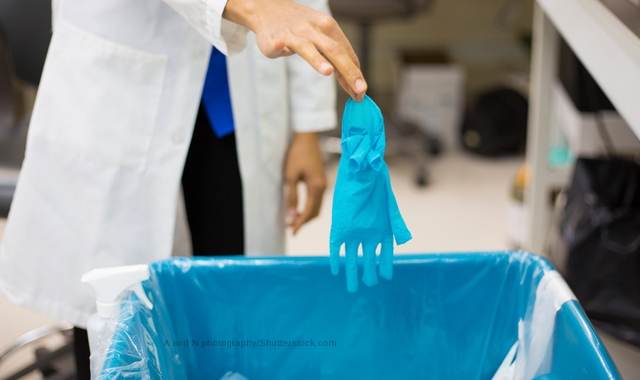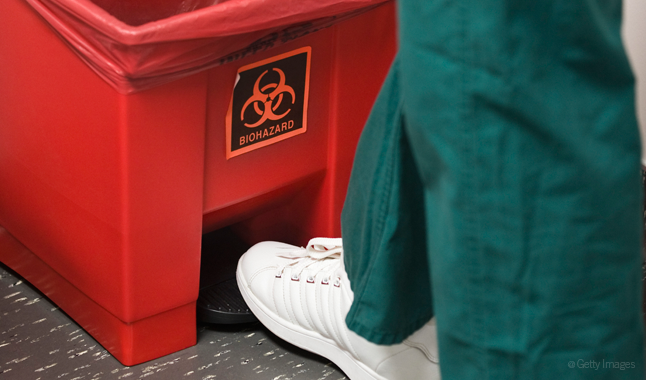6 Scary Consequences of Not Following Good Infection Control Practices
An exploration of some of the problems and practice-endangering penalties that can occur due to poor infection control protocols.
It should go without saying that every practice should follow proper infection control protocols. Those reasons run from seemingly obvious to somewhat tangential.

Must read: 4 extreme measures taken in the name of infection control
We talked to infection control experts to find out why they remind dental professionals that bad things can happen when proper infection control protocols are not followed.

A threat to professionalism
While patients go to the dentist for treatment and care, it is a place of business for the people who work there. Poor infection control habits can threaten that environment.
“Employers will have a set of expectations, whether communicated verbally or in writing,” says Karen Daw, an infection control consultant and former Clinic Health and Safety Director for the Ohio State University College of Dentistry. “They can include personal hygiene, behavior and following established standards for safety and infection control. It’s highly likely that we are aware that gloves will be worn with every patient, that instruments will be sterilized between use, and so forth. Therefore, when these expectations are breached, the employer will take action. This could include a reminder or coaching session to immediate termination, depending upon severity.”
Related: 5 benefits of good infection control
Even worse, patients might even be exposed to that breach of professionalism.
“I once visited an office where a hygienist threw a contaminated instrument at another hygienist,” Daw illustrates. “They were arguing in full view of patients. Not only did this reflect poorly on the practice, but more importantly, someone could have been severely injured with long term medical consequences. The doctor immediately dismissed one of them on the spot.”
And doctors have good reason to take workplace professionalism seriously.
“Remember, if OSHA is involved, the employer-not the employee-pays the fine,” Daw observes. “So not following proper infection control procedures can land you in disciplinary hot water with the boss.”

Environmental perils
Infection control policies, procedures and protocols exist for a reason: to keep everyone-patients and staff, alike-safe. And those processes necessarily involve both the big and little things.
“With Hepatitis B and C, and also HIV, a possibility, it’s just critical for the practice to train their workers on the exposure risks and provide the personal protective equipment-and then monitor and ensure at the workers are doing what they’ve been instructed to do,” Mary Borg-Bartlett, President of SafeLink Consulting observes.
Popular on the site: 7 ways infection control mistakes can endanger your practice
No measure is too insignificant. If an infection control rule is in place, it is there for a reason.
“For example, if you do not follow manufacturer’s instructions for use regarding disinfection contact time, you may not be giving the product enough time to kill pathogens,” Daw says. “Hepatitis C, as an example, can survive for several weeks on contaminated surfaces. If you’re using a product with a five-minute kill time, but only leaving it wet for 20 seconds, you may as well be using water on those surfaces. Instructions for proper use must be followed, including whether the product requires an additional cleaning step before disinfection and what the contact time is to kill all pathogens indicated on the label. Not doing so can create an environment rife with contaminants.”

Risk of injury
Without question, the worst result of failing to follow proper infection control procedures is that it can cause serious harm to a team member, a patient or even one’s self.
“I don’t believe anybody entered into the dental profession to intentionally cause harm,” Daw observes. “So, when there is an infection control breach that harms another, any normal person would feel badly.”
That level of harm can be physical or mental; and even has the potential to affect thousands of people.
“Someone on the receiving end of an infection control breach may undergo blood testing, take medication and lose sleep waiting on test results,” Daw says. “A few years ago, an oral surgery clinic had a major infection control breach. Several thousand people were affected.”
Free eBook: The 5 common myths of disinfection
Proper infection control protocols may seem overly fussy. However, it is important to engender a culture where good infection control is the standard.
“For many years at OSU, I worked for a clinic dean with a strong commitment to safety,” Daw says. “Dedicated meetings, trainings and ongoing observations were part of a robust and comprehensive safety program to ensure students, patients and employees participated in the safest environment. This is the same in many community clinics and private practices; we all do what we can to ensure a safe work environment. If we’re not following proper infection control protocols, a student, employee or patient can be impacted.”

Needlesticks
No one likes getting stuck with a needle, but it’s even more concerning if that needle is contaminated. Practices can lessen their chances for needlesticks by making sharps containers easier to get at.
“We’re still hearing about many needlesticks,” Borg-Bartlett says, “And the practice is putting itself in that position if it is using a central sharps container. It’s better to have the container at the point of use, such as in the treatment room for easy disposal.”
Related reading: The 5 things you should be doing NOW for better infection control
When practices have centralized sharps disposal locations, the dirty needles must be transported, increasing the risk for accidents.
“The risk is during the transport of the needle into the central disposal area which increases the risk of a needlestick,” Borg-Bartlett says. “Every year, dental practices need to evaluate safe practices for using needles and disposal. Last year the CDC included in their Summary of Infection Prevention Practices in Dental Settings the need for more attention and evaluation of safe injection practices to avoid transmission of infectious diseases by inappropriate handling of injectable medications.”

Third-party informants
Good infection control practices are not only necessary for the sake of avoiding incidents, but also because it creates an environment where infection control is the norm. Unfortunately, if that culture does not exist, practices might find themselves being sanctioned, not because of a visiting OSHA inspector, but because of a third-party with an axe to grind.
Must read: 6 overlooked areas in your office that can improve infection control
“Most OSHA inspections are a result of a complaint by an employee, a former employee, or someone outside the practice,” Borg-Bartlett says. That possibility of being reported to authorities underscores another reason why suitable protocols should just be second nature.
“Complaints from employees or former employees are the primary cause of a dental practice receiving an OSHA visit; therefore, the practice is putting itself at great risk if it hasn’t implemented an effective safety program,” Borg-Bartlett says.

Penalties
If the threat of physical harm is not enough to inspire the practice to consider safe infection control practices, then there is always a financial concern. OSHA penalties can run in the tens of thousands of dollars. Fines can be more than $100,000, if practices are especially slipshod.
“Most practices don’t allow for penalties and fines in their annual budgets, and the financial consequences of the penalty for most can be burdensome,” Borg-Bartlett says.
Worth thinking about: The challenges of waterline disinfection
“As far as the fines, OSHA has increased them as of January 1 of this year.”
Violations, and their resulting fines, are grouped into various categories. The most prevalent categories are: Serious, Other-Than-Serious and Posting Requirements.
“The most common citation for dental practices results in non-compliance with the Bloodborne Pathogen Standard,” Borg-Bartlett says. “The starting penalty for this type of violation would be $12,675 per violation. OSHA can cite if staff who are exposed to potentially infectious materials are not being protected by wearing adequate personal protective equipment. If there were four staff members violating the use of personal protective equipment, then each one of those is a violation and could result in a significant penalty per violation.”
Other categories of OSHA violations also affect practices.
“There’s also Failure to Abate, and that’s also at the $12,675 for violation level,” Borg-Bartlett says. “Failure to Abate means that the practice has had a visit by OSHA or has received a complaint by mail, email, or fax from OSHA and didn’t respond to OSHA in the timeframe that OSHA has indicated.”
Related: 5 ways to to improve the efficiency of your sterilization center
The most serious violation comes with the heftiest fine-and for good reason.
“The last type of violation would be a Willful or Repeated violation,” Borg-Bartlett says. “That penalty starts at $126,749 per violation, and would be the result of a practice not having a safety program in place or the practice had a prior citation and on a return visit by OSHA the same incident has not been corrected.”
There are any number of reasons to adhere to good safety protocols. Whether it is a threat to professionalism, to some sort of safety risk, or to the specter of a fine, in the long run, it is better to adhere to good infection control procedures than not.